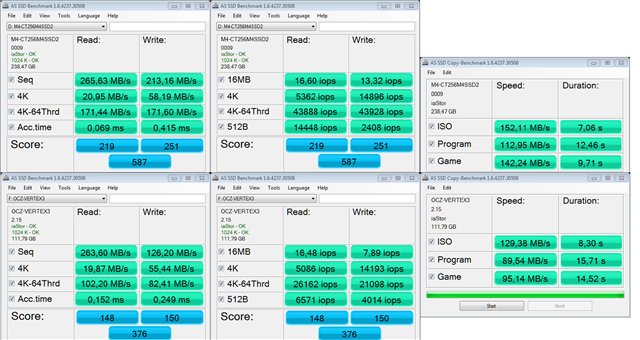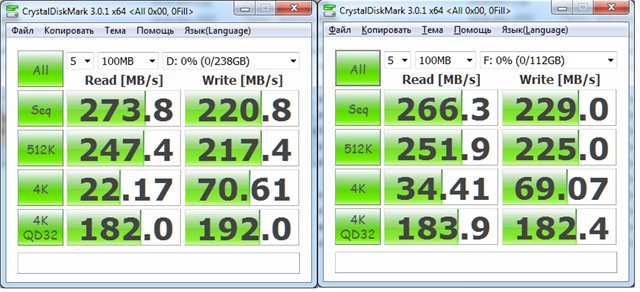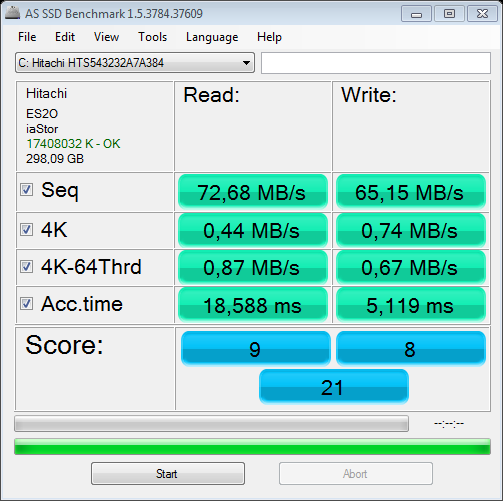Marvel or SandForce? And yet they are compressed
I want to share the result of my test, which, oddly enough, contradicts the wide-spread stereotype that SandForce drives have a “corn” performance and only Marvel drives on the choice of nelohovs.
Briefly, the essence of the claims to SF is that it demonstrates its stated speeds in tests with compressible data, and on “random” it sags heavily, and if in the first case, SF beats Marvel, then in the second, the situation changes to the opposite. Given the price / capacity ratio, few people dispute that the SSD application area is not the storage of the library and the system disk with the OS. So it shrinks or not?
By the nature of my business, I often perform the procedure “restoration of the pre-installed system manufacturer”. Everyone who bought a new laptop knows that besides Windows there is a whole bunch of necessary and not very soft software installed there. And when in the Asus warranty service you change the dead railway to a new one, then they must restore the information to “out of the box”. The recovery procedure is not complicated. The utility splits the hard disk drives into sections, then three or four files with the WIM gigs extension are dropped into 5 and five small service files. After the reboot, the recovery process starts automatically. At this point, you can forget about the existence of the laptop, because the cherished inscription on its “PASS” screen, meaning that everything went well and the device is ready for delivery to the client, it will be possible to contemplate not earlier than an hour after 2 or 4, depending on the model. At this point, our railway contains about one hundred thousand files in the amount of three dozen Gigabytes. Why so vague? We are just interested in only three points, the number of the formed files is HUGE, the increase in the volume occupied is MULTIPLE, and the execution of the procedure is IMMANIZABLE within any particular model. In the course of the procedure, the net image of the Windows version for this model is unfolded. Install all drivers and utilities that are specific to this model. Installation of proprietary and related software. Then the system cleans up after itself and, after deleting the primary files, creates an emergency recovery image for this model in the hidden section of the hard disk drive. Thus, not only is a huge amount of primary data and temporary files created but also deleted. During all this, several dozen reboots occur. Why not a typical PC user behavior model? It installs the OS, the driver, its software, downloads something, deletes something, turns on and off its computer.
Since time is money, I had to reduce the waiting time for laptop readiness for distribution to customers. I decided to carry out the procedure on a temporary SSD with the subsequent cloning of the finished system on the railway. For one, combine the useful with the pleasant and find out which SSD controller will do the job better.
The test kit consists of a laptop Asus K52J, HDD Hitachi 320G 5400rpm, SSD Crucial M4-256G (fw0009), SSD OCZ Vertex3-120G (fw2.15). From the beginning, on a regular railway, partitions were created and all source files were uploaded. Then a disk image was created on the working PC. The image was alternately deployed on both SSDs. So were obtained "source blanks", all in equal conditions. The disks were in turn inserted into the laptop and the power button was pressed, the start time was detected. The appearance of the inscription "PASS" on the screen meant recording the end of the test and turning off the laptop. The BIOS is set to SATA Mode-AHCI. And since SATA itself works in 3G / s mode, in the same mode we will get acquainted with the contestants.
')

Despite the fact that both drives are declared as SATA 6G / s (SATA3), even in the lightweight version of the use of SATA2, Crucial on Marvel is the undisputed leader. Although, if you run a test from well-compressible data, the leader changes.

Of course, not so radically, the ceiling is too low, not jump over. For example, the railway itself looks like this:

The difference is impressive. And immediately answering the question, I note that both SSDs, before the test image was deployed to them, were completely filled with incompressible data (movies).
All of the above was required only to correctly perceive the last three numbers:
- Railway 1 hour 36 minutes
- Crucial M4-256 1 hour 5 minutes
- OCZ Vertex3-120 1 hour exactly
And who would have thought, looking at the results of AS SSD.
Briefly, the essence of the claims to SF is that it demonstrates its stated speeds in tests with compressible data, and on “random” it sags heavily, and if in the first case, SF beats Marvel, then in the second, the situation changes to the opposite. Given the price / capacity ratio, few people dispute that the SSD application area is not the storage of the library and the system disk with the OS. So it shrinks or not?
By the nature of my business, I often perform the procedure “restoration of the pre-installed system manufacturer”. Everyone who bought a new laptop knows that besides Windows there is a whole bunch of necessary and not very soft software installed there. And when in the Asus warranty service you change the dead railway to a new one, then they must restore the information to “out of the box”. The recovery procedure is not complicated. The utility splits the hard disk drives into sections, then three or four files with the WIM gigs extension are dropped into 5 and five small service files. After the reboot, the recovery process starts automatically. At this point, you can forget about the existence of the laptop, because the cherished inscription on its “PASS” screen, meaning that everything went well and the device is ready for delivery to the client, it will be possible to contemplate not earlier than an hour after 2 or 4, depending on the model. At this point, our railway contains about one hundred thousand files in the amount of three dozen Gigabytes. Why so vague? We are just interested in only three points, the number of the formed files is HUGE, the increase in the volume occupied is MULTIPLE, and the execution of the procedure is IMMANIZABLE within any particular model. In the course of the procedure, the net image of the Windows version for this model is unfolded. Install all drivers and utilities that are specific to this model. Installation of proprietary and related software. Then the system cleans up after itself and, after deleting the primary files, creates an emergency recovery image for this model in the hidden section of the hard disk drive. Thus, not only is a huge amount of primary data and temporary files created but also deleted. During all this, several dozen reboots occur. Why not a typical PC user behavior model? It installs the OS, the driver, its software, downloads something, deletes something, turns on and off its computer.
Since time is money, I had to reduce the waiting time for laptop readiness for distribution to customers. I decided to carry out the procedure on a temporary SSD with the subsequent cloning of the finished system on the railway. For one, combine the useful with the pleasant and find out which SSD controller will do the job better.
The test kit consists of a laptop Asus K52J, HDD Hitachi 320G 5400rpm, SSD Crucial M4-256G (fw0009), SSD OCZ Vertex3-120G (fw2.15). From the beginning, on a regular railway, partitions were created and all source files were uploaded. Then a disk image was created on the working PC. The image was alternately deployed on both SSDs. So were obtained "source blanks", all in equal conditions. The disks were in turn inserted into the laptop and the power button was pressed, the start time was detected. The appearance of the inscription "PASS" on the screen meant recording the end of the test and turning off the laptop. The BIOS is set to SATA Mode-AHCI. And since SATA itself works in 3G / s mode, in the same mode we will get acquainted with the contestants.
')

Despite the fact that both drives are declared as SATA 6G / s (SATA3), even in the lightweight version of the use of SATA2, Crucial on Marvel is the undisputed leader. Although, if you run a test from well-compressible data, the leader changes.

Of course, not so radically, the ceiling is too low, not jump over. For example, the railway itself looks like this:

The difference is impressive. And immediately answering the question, I note that both SSDs, before the test image was deployed to them, were completely filled with incompressible data (movies).
All of the above was required only to correctly perceive the last three numbers:
- Railway 1 hour 36 minutes
- Crucial M4-256 1 hour 5 minutes
- OCZ Vertex3-120 1 hour exactly
And who would have thought, looking at the results of AS SSD.
Source: https://habr.com/ru/post/133817/
All Articles